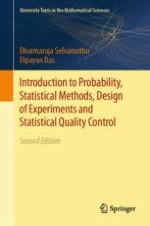This revised book provides an accessible presentation of concepts from probability theory, statistical methods, the design of experiments, and statistical quality control. It is shaped by the experience of the two teachers teaching statistical methods and concepts to engineering students. Practical examples and end-of-chapter exercises are the highlights of the text, as they are purposely selected from different fields. Statistical principles discussed in the book have a great relevance in several disciplines like economics, commerce, engineering, medicine, health care, agriculture, biochemistry, and textiles to mention a few.
Organised into 16 chapters, the revised book discusses four major topics—probability theory, statistical methods, the design of experiments, and statistical quality control. A large number of students with varied disciplinary backgrounds need a course in basics of statistics, the design of experiments and statistical quality control at an introductory level to pursue their discipline of interest. No previous knowledge of probability or statistics is assumed, but an understanding of calculus is a prerequisite. The whole book also serves as a master level introductory course in all the three topics, as required in textile engineering or industrial engineering.
